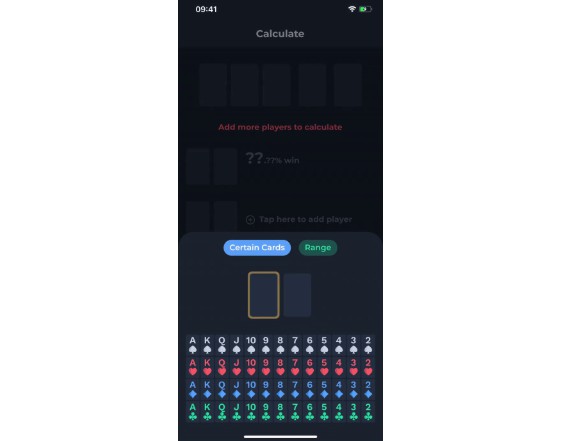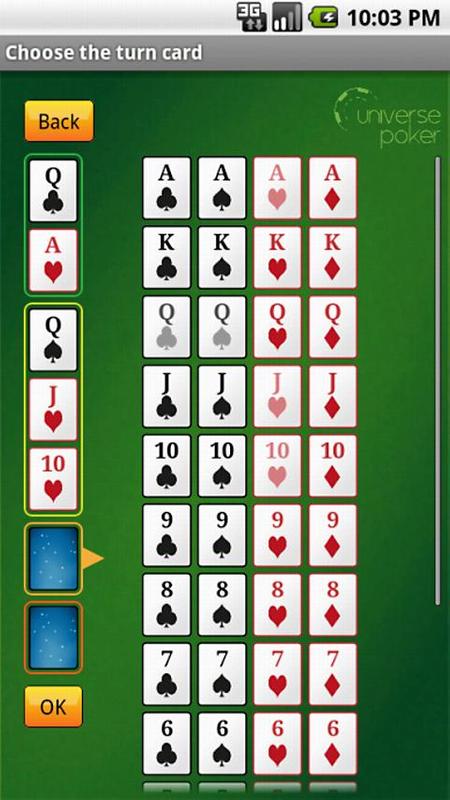#1 Ranked Poker Odds Calculator from CardsChat™ - Easy & FREE tool for calculating odds for Hold'em, Omaha & more. Also on Google Play & App Store.
- Poker Guide
- Learn to Play Poker: Getting Started
- Poker Game Variations
- Texas Hold ‘em Guide
- Learn to Play Texas Hold ‘em
- Hold ‘em Gameplay
- Texas Hold ‘em Strategy
- Beginner Hold ‘em Strategy
- Intermediate Hold ‘em Strategy
- Blackjack Guide
- Learn to Play Blackjack
- Blackjack Dealing
- Blackjack Strategy
- Blackjack Resources
- Roulette Guide
- Learn to Play Roulette
- Roulette Strategy
- Roulette Types and Variations
- Roulette Resources
- Slots Guide
- Learn to Play Slots
- Slots Games and Variations
- Slots Tips
Once you familiarize yourself with basic Texas Hold ‘em play, hand rankings and dealing, you should learn about the odds and probabilities associated with different aspects of the game. While it may be impossible to calculate precise odds mid-hand, particularly given you’ll never see your opponents’ cards until all decisions have been made, knowing when to play (and when not to play) different hands typically requires more than just good instinct.
In Texas Hold ‘em, winners are often decided before the community cards are even laid out, so the chances of being dealt a strong starting hand is something many players think.
Calculating Texas Hold ‘em Odds
To understand the odds of drawing any particular starting hand, you’ll have to consider all of the factors that go into the deal of a hand. Considering a shuffle to completely randomize the order of the cards, the biggest factors that will affect a draw are the number of players at the table and your own position relevant to the dealer. Also consider that there are four cards of any given value in each deck and there are 169 different hole card combinations. That being said, there’s a roughly one in 1326 chance that players will be dealt any specific hand, so it’s important to know what kind of odds you should keep in mind whenever you step to the poker table.
Pre Flop
You have a 55:1 chance of being dealt a pair of Jacks or higher.
Your Texas Hold’em experience will begin with your hole cards, and while you cannot change the cards that are dealt your way, it’s good to know what to expect. While World Series of Poker reruns may make it seem like someone at the table will be dealt pocket kings every hand, starting with a monster hand is rarer than you may imagine. For more on Pre Flop strategy see our guide here.
Quick Odds
While an extensive list of the probabilities for preflop hands could fill a book, here are some quick odds to consider when you’re peeking at your cards for the first time.
- Being dealt a pocket pair: 16:1
- Being dealt suited cards: 3.2:1
- Being dealt suited connectors: 24:1
- Being dealt AK: 82:1
- Being dealt two cards of jack or higher: 10:1
- Being dealt AA, KK, QQ or JJ: 55:1
The Flop
The flop is a game changer in every sense of the words. With more cards in your hand, players will get their first real taste of what the final outcome will look like. That being said, players will want to think about the odds for how their hand could turn out before they start placing or calling bets. For more on Post Flop strategy see our guide here.
Quick Odds
Though the presented odds may be mathematically accurate, they do present a best case scenario that you won’t always find yourself in at the table. These calculations don’t take into account the probabilities of the card or cards you are looking for turning up as burn cards or in your opponents’ hands, so keep that in mind when considering your next move.
- Hitting a pair on the flop: 2:1
- Pocket pair improving to three of a kind on the flop: 7:1
- Flop being three of a kind: 424:1
- Odds of flopping a flush with suited hole cards: 118:1
The odds of flopping a straight can be a bit harder to pin down. Depending on your starting hand, there are any number of card combinations that could lead to a flopped straight. Those hands that have the more flexibility when it comes to straight draws, particularly middling connectors (those between 5 and 9), have the strongest chances of hitting on the flop because there are more cards that could allow for their straight to hit. The wider the gap between your starting cards, the worse your chances are.
The Turn and River
Naturally, as the hand progresses and fewer cards remain to be dealt, the odds of making any particular hand become slimmer and slimmer. That being said, you’ll want to look at the odds for a hand from beginning to end as well as those from stage to stage.
Texas Holdem Odds Calculator
Quick Odds
Your odds change as each new card is dealt.
Over the course of a full hand, these scenarios could play out
- One pair on flop improving to two pair or a set by the river: 4:1
- Catching an ace on the turn or river: 7:1
- Open ended straight hitting by the river: 2:1
- Gutshot straight draw hit by the river: 5:1
- Pocket pair improving to set by river: 10:1
- Going runner runner for a flush: 23:1
- Going runner runner for a straight: 67:1
Pot and Implied Odds

In addition to the odds that your cards will pair or better, experienced players know that pot odds, that is, the ratio of the size of the pot to the cost of a call, play an important role in proper Hold’em strategy. With all of the risks that are inherently involved in games like poker, players won’t get far if they don’t decide to gamble every so often – and pot odds allow you to make smarter decision when it comes time to place your money on the line. Pot odds take into consideration the likelihood of making a hand to establish a decent risk vs. reward ratio.
Another important statistic for players to keep in mind is ‘implied odds,’ which factor in the likely size and frequency of any betting that may come in later rounds of play. These come into play post flop and will be a factor until the river is dealt, and unlike most other Texas hold ’em odds, implied odds will be entirely based on your read on your opponents’ betting habits and aggression.
Poker Odds In Texas Holdem

To calculate effective pot odds, consider your position in the hand and relative strength, then make a note of the amount of money currently in the pot. If you’re in a position to call, think of how much you stand to win should your hand come out ahead, as establishing a solid return on investment can help turn a questionable call into a big win. If no one has bet, then pot odds can help you deduce what size bet you will want to make in order to shift the statistical probabilities in your favor. With a sound bet, you could either make the continued investment not worth the potential gain or place a value wager designed to elicit a call from any remaining opponents. You will have to decide whether or not your chances of winning are worth risking the amount you could lose if you are wrong – a fine line for some players, but one that must be crossed often. For more on Texas Hold’em pot size and strategy see our guide here.
Is there an easier way to calculate pot odds?
Thankfully, there are several short cuts that have been devised to make a quick judgment for pot odds.
(Total Outs x 2) + 2
One of the easiest methods I have found is to take your total outs, multiply times 2, and then add 2. This is roughly a percentage chance of making your hand.
Using one of our examples above, your inside straight draw has 4 outs. 4x2 = 8. Add 2, for a total of 10. You have roughly a 10% chance to make your hand. Your call should be no more than 10% of what is already in the pot. This method is quick and decently effective, though certain calculations will be a bit off. This method does not take into consideration the fact that you may have more than one card remaining to come, it simply estimates your chance of hitting your “out” on your next card.
Do you know of other pot odds shortcuts? Please take a moment to share them in our forums. We are always looking to learn new and creative methods that do not include using a calculator at the poker table!